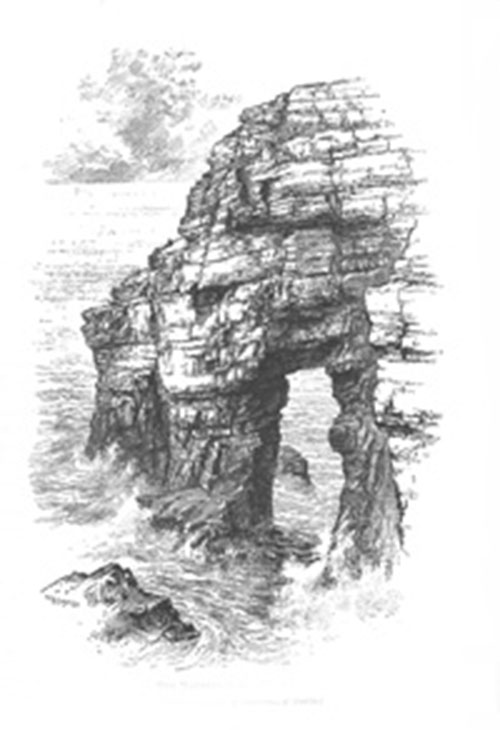Dunfanaghy and Tory Island - Irish Pictures (1888)
From Irish Pictures Drawn with Pen and Pencil (1888) by Richard Lovett
Chapter VIII: The Donegal Higlands … continued
« Previous Page | Start of Chapter | Book Contents | Next Page »
Dunfanaghy, some seventeen miles from Gweedore, is an interesting little town with a capital hotel, and a considerable amount of life about it, by reason of the mail and tourist traffic with Letterkenny. The two lions of the district are Horn Head and Tory Island. The former is a huge promontory jutting out into the Atlantic, equipped with all the needful qualities to charm the eye and satisfy adventurous spirits bent upon exploration, viz., bold cliffs rising from 500 to 700 feet above the sea, caves which can only be visited by boat, natural arches and a great puffing hole known as MacSwyne's Gun. Horn Head, so called because when seen from a certain point of view the cliff seems to possess two horns, forms a kind of ultima thule, and ranks high among the famous points of the Donegal coast. We give an engraving of a splendid natural arch to be seen on the western cliffs of Horn Head. MacSwyne's Gun is a rocky cavern open at the top, through which the sea at times forces waves with such tremendous violence that great blocks of stone are hurled up on the shore with a noise which, according to the natives, can be heard thirty miles!
Tory Island is about eight miles distant from the coast, and is inhabited by a race of fishermen possessed of striking peculiarities, like the Arran Islanders. It also contains a ruined Round Tower, and a monastery is said to have been founded on the island by Columba. It is not an easy place to reach, as the author found, for although an expedition had been kindly planned for him, the weather did not prove propitious. We could have reached the island, but the boatmen were by no means certain when we should be able to return. In fact, the best view I had of it was when from the peak of Errigal it looked like a lovely gem set in the brilliant blue of the Atlantic, and appeared to be only two or three instead of fifteen or twenty miles away. It is about three miles long and one wide, containing about 1,200 acres, of which 200 can be cultivated. At the north-western end there is a fine lighthouse. The inhabitants live by fishing, by agriculture, and by kelp-making; the last occupation is common to many parts of the Irish coast, and consists of collecting sea-weed on the beach and burning it into kelp, which was formerly purchased because of its iodine-producing qualities. The inhabitants naturally are skilful in the management of the curragh.
From Dunfanaghy there are two routes open to the traveller. The least interesting is by the mail road to Letterkenny, where he touches civilization again in the form of the railroad. The other is to make his way around the great inlets of the Atlantic on the north coast of Donegal until he reaches Lough Swilly. This route, unless he happens to be familiar with the country and people, or to have the assistance of local friends, is somewhat rough, and is only to be recommended to those who rate making the acquaintance of new country and truly primitive people a higher pleasure than the mere enjoyment of creature comforts. Such will find the district of Fanet between Dunfanaghy and Port Salon on Lough Swilly a happy hunting-ground. Sheephaven is the first of these great arms of the sea which have to be skirted, the road passing Creeslough, then running along by the Duntally River and crossing the Lackagh, that river famous not only for its salmon, but for a great law-suit in the time of the late Lord Leitrim. Ards House, the mansion belonging to what used to be one of the wealthiest estates in Ireland, and Doe Castle are passed, and at every half-mile most charming views are enjoyed. Lough Glen, Kilmacrenan, Lough Salt, and Lough Fern well repay alike the lover of the beautiful and the angler for the time and attention he can bestow upon them.
« Previous Page | Start of Chapter | Book Contents | Next Page »

